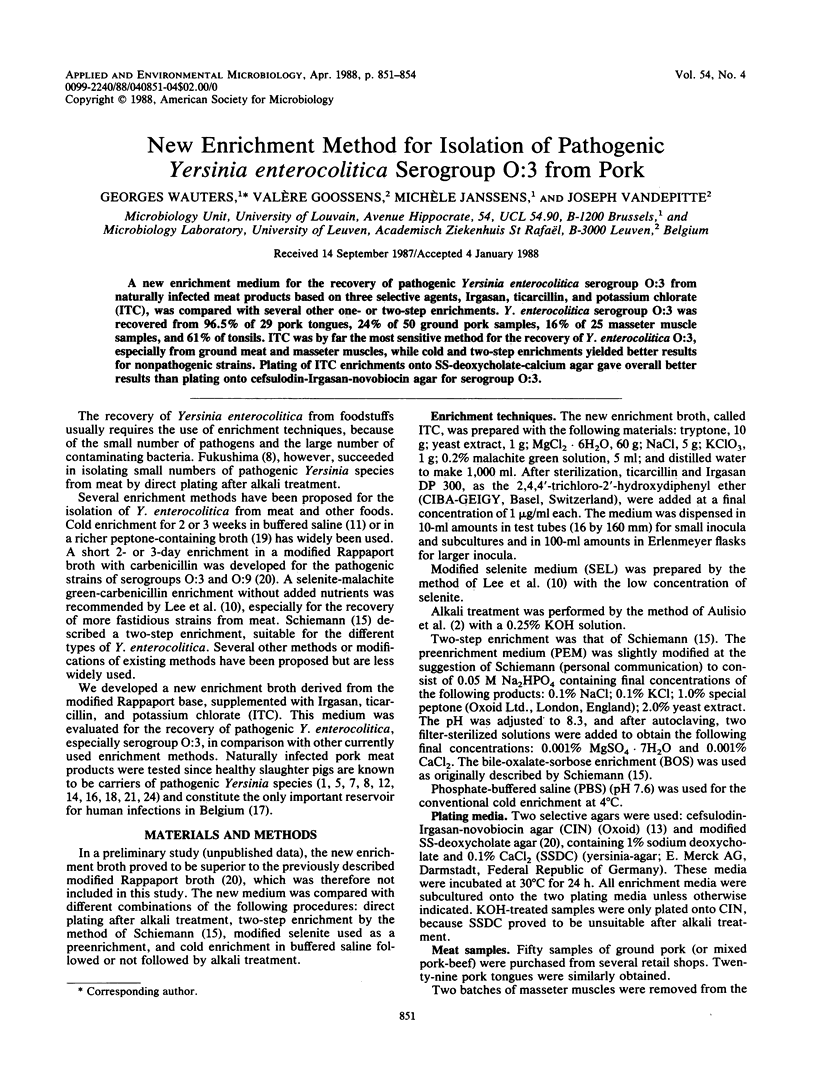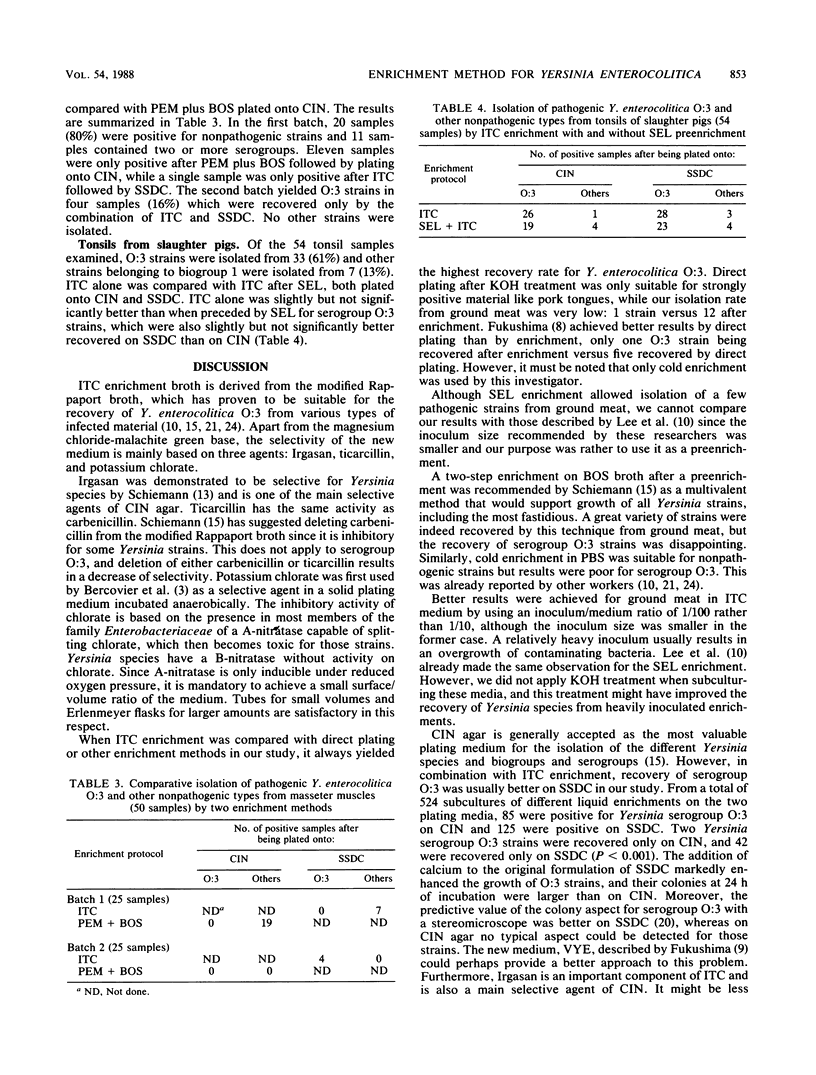Abstract
A new enrichment medium for the recovery of pathogenic Yersinia enterocolitica serogroup O:3 from naturally infected meat products based on three selective agents, Irgasan, ticarcillin, and potassium chlorate (ITC), was compared with several other one- or two-step enrichments. Y. enterocolitica serogroup O:3 was recovered from 96.5% of 29 pork tongues, 24% of 50 ground pork samples, 16% of 25 masseter muscle samples, and 61% of tonsils. ITC was by far the most sensitive method for the recovery of Y. enterocolitica O:3, especially from ground meat and masseter muscles, while cold and two-step enrichments yielded better results for nonpathogenic strains. Plating of ITC enrichments onto SS-deoxycholate-calcium agar gave overall better results than plating onto cefsulodin-Irgasan-novobiocin agar for serogroup O:3.
Full text
PDF



Selected References
These references are in PubMed. This may not be the complete list of references from this article.
- Asakawa Y., Akahane S., Shiozawa K., Honma T. Investigations of source and route of Yersinia enterocolitica infection. Contrib Microbiol Immunol. 1979;5:115–121. [PubMed] [Google Scholar]
- Aulisio C. C., Mehlman I. J., Sanders A. C. Alkali method for rapid recovery of Yersinia enterocolitica and Yersinia pseudotuberculosis from foods. Appl Environ Microbiol. 1980 Jan;39(1):135–140. doi: 10.1128/aem.39.1.135-140.1980. [DOI] [PMC free article] [PubMed] [Google Scholar]
- Christensen S. G. The Yersinia enterocolitica situation in Denmark. Contrib Microbiol Immunol. 1987;9:93–97. [PubMed] [Google Scholar]
- Doyle M. P., Hugdahl M. B. Improved procedure for recovery of Yersinia enterocolitica from meats. Appl Environ Microbiol. 1983 Jan;45(1):127–135. doi: 10.1128/aem.45.1.127-135.1983. [DOI] [PMC free article] [PubMed] [Google Scholar]
- Fukushima H. Direct isolation of Yersinia enterocolitica and Yersinia pseudotuberculosis from meat. Appl Environ Microbiol. 1985 Sep;50(3):710–712. doi: 10.1128/aem.50.3.710-712.1985. [DOI] [PMC free article] [PubMed] [Google Scholar]
- Fukushima H. New selective agar medium for isolation of virulent Yersinia enterocolitica. J Clin Microbiol. 1987 Jun;25(6):1068–1073. doi: 10.1128/jcm.25.6.1068-1073.1987. [DOI] [PMC free article] [PubMed] [Google Scholar]
- Lee W. H., Harris M. E., McClain D., Smith R. E., Johnston R. W. Two modified selenite media for the recovery of Yersinia enterocolitica from meats. Appl Environ Microbiol. 1980 Jan;39(1):205–209. doi: 10.1128/aem.39.1.205-209.1980. [DOI] [PMC free article] [PubMed] [Google Scholar]
- PATERSON J. S., COOK R. A method for the recovery of Pateurella pseudotuberculosis from faeces. J Pathol Bacteriol. 1963 Jan;85:241–242. doi: 10.1002/path.1700850124. [DOI] [PubMed] [Google Scholar]
- Pedersen K. B. Occurrence of Yersinia enterocolitica in the throat of swine. Contrib Microbiol Immunol. 1979;5:253–256. [PubMed] [Google Scholar]
- Schiemann D. A. Development of a two-step enrichment procedure for recovery of Yersinia enterocolitica from food. Appl Environ Microbiol. 1982 Jan;43(1):14–27. doi: 10.1128/aem.43.1.14-27.1982. [DOI] [PMC free article] [PubMed] [Google Scholar]
- Schiemann D. A. Synthesis of a selective agar medium for Yersinia enterocolitica. Can J Microbiol. 1979 Nov;25(11):1298–1304. doi: 10.1139/m79-205. [DOI] [PubMed] [Google Scholar]
- Tauxe R. V., Vandepitte J., Wauters G., Martin S. M., Goossens V., De Mol P., Van Noyen R., Thiers G. Yersinia enterocolitica infections and pork: the missing link. Lancet. 1987 May 16;1(8542):1129–1132. doi: 10.1016/s0140-6736(87)91683-7. [DOI] [PubMed] [Google Scholar]
- Toma S., Deidrick V. R. Isolation of Yersinia enterocolitica from swine. J Clin Microbiol. 1975 Dec;2(6):478–481. doi: 10.1128/jcm.2.6.478-481.1975. [DOI] [PMC free article] [PubMed] [Google Scholar]
- Wauters G. Carriage of Yersinia enterocolitica serotype 3 by pigs as a source of human infection. Contrib Microbiol Immunol. 1979;5:249–252. [PubMed] [Google Scholar]
- Wauters G., Kandolo K., Janssens M. Revised biogrouping scheme of Yersinia enterocolitica. Contrib Microbiol Immunol. 1987;9:14–21. [PubMed] [Google Scholar]
- Weber A., Lembke C. Vergleichende Anwendung von zwei Anreicherungsverfahren und fünf selektivnährböden zur Isolierung von Yersinia enterocolitica aus Tonsillen von Schlachtschweinen. Zentralbl Bakteriol Mikrobiol Hyg A. 1981;250(1-2):72–77. [PubMed] [Google Scholar]
- de Groote G., Vandepitte J., Wauters G. Surveillance of human Yersinia enterocolitica infections in Belgium: 1963-1978. J Infect. 1982 May;4(3):189–197. doi: 10.1016/s0163-4453(82)92374-x. [DOI] [PubMed] [Google Scholar]
- van Pee W., Stragier J. Evaluation of some cold enrichment and isolation media for the recovery of Yersinia enterocolitica. Antonie Van Leeuwenhoek. 1979;45(3):465–477. doi: 10.1007/BF00443284. [DOI] [PubMed] [Google Scholar]


